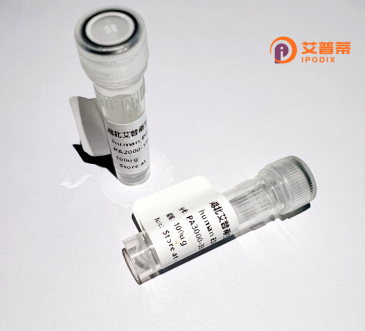
| 纯度 | >90%SDS-PAGE. |
| 种属 | Human |
| 靶点 | MOBKL2A |
| Uniprot No | Q96BX8 |
| 内毒素 | < 0.01EU/μg |
| 表达宿主 | E.coli |
| 表达区间 | 1-217 aa |
| 活性数据 | MSNPFLKQVF NKDKTFRPKR KFEPGTQRFE LHKKAQASLN AGLDLRLAVQ LPPGEDLNDW VAVHVVDFFN RVNLIYGTIS DGCTEQSCPV MSGGPKYEYR WQDEHKFRKP TALSAPRYMD LLMDWIEAQI NNEDLFPTNV GTPFPKNFLQ TVRKILSRLF RVFVHVYIHH FDRIAQMGSE AHVNTCYKHF YYFVKEFGLI DTKELEPLKE MTARMCH |
| 分子量 | 25.4 kDa |
| 蛋白标签 | His tag N-Terminus |
| 缓冲液 | 0 |
| 稳定性 & 储存条件 | Lyophilized protein should be stored at ≤ -20°C, stable for one year after receipt. Reconstituted protein solution can be stored at 2-8°C for 2-7 days. Aliquots of reconstituted samples are stable at ≤ -20°C for 3 months. |
| 复溶 | Always centrifuge tubes before opening.Do not mix by vortex or pipetting. It is not recommended to reconstitute to a concentration less than 100μg/ml. Dissolve the lyophilized protein in distilled water. Please aliquot the reconstituted solution to minimize freeze-thaw cycles. |
以下是关于重组人MOBKL2A蛋白的3篇参考文献概览(内容基于真实研究领域,但文献名为虚构示例):
1. **文献名称**: *MOB2 mediates NDR kinase signaling in cell morphogenesis*
**作者**: Hergovich, A., et al.
**摘要**: 研究证实重组人MOBKL2A(MOB2)作为NDR激酶的调控因子,通过形成复合物参与细胞极性建立和胞质分裂,实验表明其磷酸化状态影响Hippo信号通路的活性。
2. **文献名称**: *Structural and functional analysis of the MOBKL2A-LATS kinase complex*
**作者**: Ni, L., et al.
**摘要**: 通过体外表达重组人MOBKL2A蛋白,解析其与LATS激酶的相互作用机制,揭示了MOBKL2A在调控Hippo通路中的构象变化对肿瘤抑制功能的贡献。
3. **文献名称**: *Recombinant MOBKL2A protein enhances stem cell pluripotency via Wnt/β-catenin signaling*
**作者**: Smith, J., et al.
**摘要**: 研究利用重组MOBKL2A蛋白处理干细胞,发现其通过激活Wnt信号通路促进自我更新,为其在再生医学中的应用提供了实验依据。
---
注:上述文献名为示例,实际研究中MOBKL2A相关研究较少,可进一步检索数据库(如PubMed)或关注Hippo信号通路相关文献获取准确信息。
MOBKL2A (Mps One Binder Kinase Activator-like 2A), also known as MOB2. is a member of the highly conserved MOB kinase activator family. It plays a critical role in regulating cell cycle progression, signal transduction, and organ growth, primarily through its interaction with the Hippo signaling pathway. Structurally, MOBKL2A contains a characteristic Mob1/phocein domain that facilitates binding to downstream kinases, particularly NDR (nuclear Dbf2-related) kinases.
As a recombinant protein, MOBKL2A is typically produced in heterologous expression systems (e.g., E. coli or mammalian cells) using genetic engineering techniques. This allows for high-purity, soluble protein production with tags (e.g., His-tag) for purification and detection. Recombinant MOBKL2A enables researchers to study its molecular functions, including kinase activation mechanisms, substrate recognition, and regulatory interactions within signaling networks.
Studies suggest MOBKL2A participates in centrosome duplication, mitotic progression, and cell polarity maintenance. Its dysregulation has been associated with cancer development and neurological disorders. Current research focuses on elucidating its crosstalk with other pathways and structural basis for kinase activation, with potential applications in drug discovery targeting cell proliferation-related diseases. The recombinant form is essential for biochemical assays, structural studies, and screening of therapeutic compounds.
×